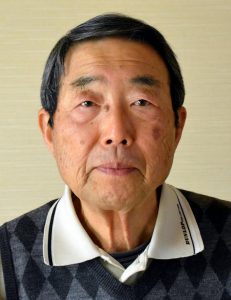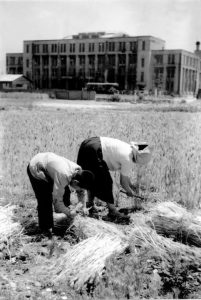Documenting Hiroshima 80 years after A-bombing: On May 29, 1948, wheat field cultivated on scorched ruins in central Hiroshima due to food shortages
Feb. 4, 2025
by Kyosuke Mizukawa, Senior Staff Writer
On May 29, 1948, the Yukan Hiroshima, an evening newspaper published by a separate company affiliated with the Chugoku Shimbun, carried a photograph of a field of wheat near Hiroshima City Hall. The photo’s headline read, “Peaceful wheat harvest on scorched remains of village in Hiroshima County.” The headline likened the scene of citizens cultivating land in the city’s center amid food shortages to a farming village.
The boy harvesting wheat in the photo was Takashi Suzuki, five years old at the time and now 82, a resident of the town of Kumano-cho in Hiroshima Prefecture, who was living in a shack adjacent to the wheat field. Both Mr. Suzuki and his mother, Takiyo, who died in 2000 at the age of 83, were captured in the photo. “According to what my mother told me, a man casually appeared and asked her ‘please let me take a photograph,’” said Mr. Suzuki.
On the morning of August 6, 1945, three years before the photo was taken, Mr. Suzuki, who had just turned three, had been at his family home in the area of Funairinaka-machi (in Hiroshima’s present-day Naka Ward), around 1.2 kilometers from the hypocenter. He and his grandmother fled from an opening in the collapsed house, but his cheek and arms were injured from broken glass.
His mother experienced the bombing while she was outside their home. His family started their life as evacuees at an air-raid shelter they had discovered to the west of City Hall. His father joined them when he had been demobilized from the military after the war’s end. Mr. Suzuki said, “When I picked up some cardboard that had rolled toward me on a windy day and brought it home, my father heaped praise on me because it could be spread over the dirt in holes at the shelter.” After a while, the family started living in a nearby shack they had built.
Delay in distribution of rations continued
During the period after the war, people in Hiroshima continued to experience delays in distribution of such staple foods as rice and wheat caused by the food shortages. Shinso Hamai, who served as deputy mayor of Hiroshima starting in December 1945 and then became mayor starting in April 1947, recalled that the dire situation had reached a peak around the summer of 1946. In his book Genbaku Shicho (in English, ‘A-bomb mayor’), published in 1967, Mr. Hamai wrote, “The food situation of citizens had deteriorated to such an extent that they could no longer depend on laws or regulations.”
Mr. Hamai explained in the book that was the reason the city “instructed and recommended that citizens cultivate as much food as possible such as sweet potatoes, pumpkins or whatever, regardless of whether the vacant land in the scorched ruins was their own or someone else’s.” The city went ahead with the measure under the condition that the city would return the cultivated land if the owner ever needed to use it.
To survive, Mr. Suzuki’s family cultivated the scorched ruins right in front of them. “We grew sweet potatoes and pumpkins,” he said. As the food shortage worsened, they ate sweet potato stems and edible grasses. The article with the photo of the wheat field offered praise for the efforts made to cultivate the land. “The hard work of a mother and a boy in order to survive the summer was rewarded with a wonderful wheat harvest,” read the article.
However, efforts to rebuild the city were ramping up gradually. In December 1949, the city ordered Mr. Suzuki family’s shack to be removed by the end of January 1950, due to “implementation of a land readjustment project for reconstruction,” which is language taken from the city’s mandate document issued at the time. The family hastily moved to the banks of the Motoyasu River, located around 400 meters to the west.
Photo also carried in Hiroshima City public relations magazine
“Our shack had walls of sheet metal, a six-tatami-mat room, and small kitchen. It was truly a makeshift hut.” His family moved to a separate location later, and finally settled in an area that was then known as Otemachi 9-chome (in Hiroshima’s present-day Naka Ward) around 1953. He began to work as a newspaper delivery boy when he was a fifth-year student at elementary school, financially helping out his family of seven, which included his younger brother and sister, who had been born after the end of the war.
The photo of their wheat field was later carried in a city public relations magazine as an image showing the post-war recovery period. Mr. Suzuki’s mother carefully held on to the magazine with a note she had added that read, “Place of painful memories.” At present, National Route 2 runs over the area where the family had once cultivated wheat.
(Originally published on February 4, 2025)
On May 29, 1948, the Yukan Hiroshima, an evening newspaper published by a separate company affiliated with the Chugoku Shimbun, carried a photograph of a field of wheat near Hiroshima City Hall. The photo’s headline read, “Peaceful wheat harvest on scorched remains of village in Hiroshima County.” The headline likened the scene of citizens cultivating land in the city’s center amid food shortages to a farming village.
The boy harvesting wheat in the photo was Takashi Suzuki, five years old at the time and now 82, a resident of the town of Kumano-cho in Hiroshima Prefecture, who was living in a shack adjacent to the wheat field. Both Mr. Suzuki and his mother, Takiyo, who died in 2000 at the age of 83, were captured in the photo. “According to what my mother told me, a man casually appeared and asked her ‘please let me take a photograph,’” said Mr. Suzuki.
On the morning of August 6, 1945, three years before the photo was taken, Mr. Suzuki, who had just turned three, had been at his family home in the area of Funairinaka-machi (in Hiroshima’s present-day Naka Ward), around 1.2 kilometers from the hypocenter. He and his grandmother fled from an opening in the collapsed house, but his cheek and arms were injured from broken glass.
His mother experienced the bombing while she was outside their home. His family started their life as evacuees at an air-raid shelter they had discovered to the west of City Hall. His father joined them when he had been demobilized from the military after the war’s end. Mr. Suzuki said, “When I picked up some cardboard that had rolled toward me on a windy day and brought it home, my father heaped praise on me because it could be spread over the dirt in holes at the shelter.” After a while, the family started living in a nearby shack they had built.
Delay in distribution of rations continued
During the period after the war, people in Hiroshima continued to experience delays in distribution of such staple foods as rice and wheat caused by the food shortages. Shinso Hamai, who served as deputy mayor of Hiroshima starting in December 1945 and then became mayor starting in April 1947, recalled that the dire situation had reached a peak around the summer of 1946. In his book Genbaku Shicho (in English, ‘A-bomb mayor’), published in 1967, Mr. Hamai wrote, “The food situation of citizens had deteriorated to such an extent that they could no longer depend on laws or regulations.”
Mr. Hamai explained in the book that was the reason the city “instructed and recommended that citizens cultivate as much food as possible such as sweet potatoes, pumpkins or whatever, regardless of whether the vacant land in the scorched ruins was their own or someone else’s.” The city went ahead with the measure under the condition that the city would return the cultivated land if the owner ever needed to use it.
To survive, Mr. Suzuki’s family cultivated the scorched ruins right in front of them. “We grew sweet potatoes and pumpkins,” he said. As the food shortage worsened, they ate sweet potato stems and edible grasses. The article with the photo of the wheat field offered praise for the efforts made to cultivate the land. “The hard work of a mother and a boy in order to survive the summer was rewarded with a wonderful wheat harvest,” read the article.
However, efforts to rebuild the city were ramping up gradually. In December 1949, the city ordered Mr. Suzuki family’s shack to be removed by the end of January 1950, due to “implementation of a land readjustment project for reconstruction,” which is language taken from the city’s mandate document issued at the time. The family hastily moved to the banks of the Motoyasu River, located around 400 meters to the west.
Photo also carried in Hiroshima City public relations magazine
“Our shack had walls of sheet metal, a six-tatami-mat room, and small kitchen. It was truly a makeshift hut.” His family moved to a separate location later, and finally settled in an area that was then known as Otemachi 9-chome (in Hiroshima’s present-day Naka Ward) around 1953. He began to work as a newspaper delivery boy when he was a fifth-year student at elementary school, financially helping out his family of seven, which included his younger brother and sister, who had been born after the end of the war.
The photo of their wheat field was later carried in a city public relations magazine as an image showing the post-war recovery period. Mr. Suzuki’s mother carefully held on to the magazine with a note she had added that read, “Place of painful memories.” At present, National Route 2 runs over the area where the family had once cultivated wheat.
(Originally published on February 4, 2025)









